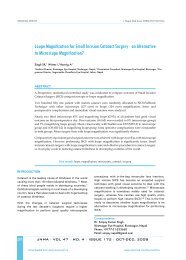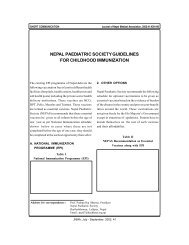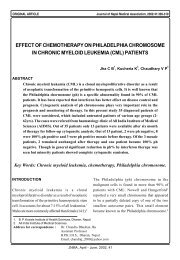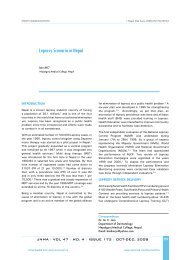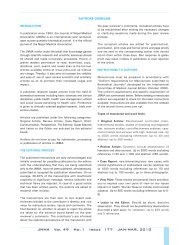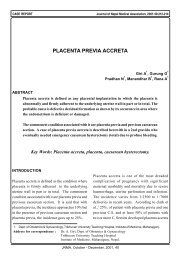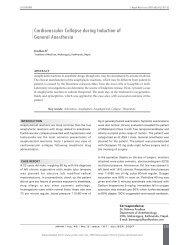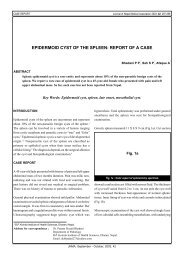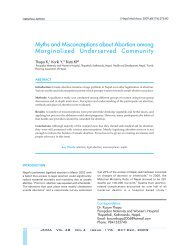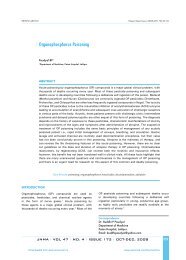KAWASAKI DISEASE - A CASE REPORT - Journal of Nepal Medical ...
KAWASAKI DISEASE - A CASE REPORT - Journal of Nepal Medical ...
KAWASAKI DISEASE - A CASE REPORT - Journal of Nepal Medical ...
- No tags were found...
Create successful ePaper yourself
Turn your PDF publications into a flip-book with our unique Google optimized e-Paper software.
<strong>CASE</strong> <strong>REPORT</strong> <strong>Journal</strong> <strong>of</strong> <strong>Nepal</strong> <strong>Medical</strong> Association 2003; 42: 235-237<strong>KAWASAKI</strong> <strong>DISEASE</strong> - A <strong>CASE</strong> <strong>REPORT</strong>Shrestha S * , Adhikari N *INTRODUCTIONKawasaki disease, first described by Tomisaku Kawasaki in1967, is an acute systemic vasculitis <strong>of</strong> infancy and childhood.It is now the leading cause <strong>of</strong> acquired heart disease indeveloped countries. The most common age group affected isbetween 6 months to 5 years and the peak incidence is inchildren aged 9 to 11 months. 1 The disease has malepreponderance with the male female ratio <strong>of</strong> 1.5:1. 2 Thoughthe exact etiology is not known the disease is known to beassociated with unusual degree <strong>of</strong> immune activation andimmunoregulatory abnormality. 3<strong>CASE</strong> <strong>REPORT</strong>A one and a half year old boy presented to us with the history<strong>of</strong> high-grade continuous fever for 4 days, skin rash mainlyover face and trunk for 3 days, irritability, poor feeding andloose stool with mucus for 2 days. Before coming to us the boywas seen by a doctor and was given amoxycillin but after 2doses <strong>of</strong> the drug, parents noticed skin rash and antibiotic wasthen changed to cefaclor. The child had 2 days <strong>of</strong> cefaclorfrom outside before seeing us.On examination, he was febrile, very irritable, toxic and sicklooking. There was macular rash over the face neck, trunkand arms. There was bilateral mild conjuctival congestion.He had hyperaemic pharyngeal and oral mucosa. There werefew palpable, non tender cervical nodes measuring 1.5 to2 cm in size and one tender left submandibular node <strong>of</strong>3x3 cm size.The boy was admitted with the provisional diagnosis <strong>of</strong> viralexanthema with viral meningitis and the differential diagnosesthen were: 1. Partially treated bacterial meningitis with drugrash: 2. Staphylococcal bacteraemia / sepsis with lymphadenitis.As the child was sick, was started empirically on injectionceftrioxone (100 mg/kg) and injection cloxacillin (100 mg/kg) after sending samples <strong>of</strong> cerebrospinal fluid (CSF), bloodand urine for cultures.The next day a few new findings were noted. There werecracked lips with red strawberry tongue. The skin rash becamemore blotchy and diffuse extending to the thighs.Swelling <strong>of</strong> the extremities involving the hands and legs withnon-pitting edema was noted.The investigation reports showed peripheral white blood cellcount (WBC) <strong>of</strong> 14,200/mm 3with neutrophil 57% andlymphocyte 43 %. The CSF analysis showed WBC <strong>of</strong> 9,neutrophil 3, lymphocyte 6, protein 32 and sugar 70 mg/dl. Urineexamination showed trace albumin with 2-3 WBC. Stoolexamination showed 20-22 WBC and 0-2 RBC (Red blood cell).Erythrocyte sedimentation rate (ESR) was 78mm/hour. Plateletscount, chest x- ray and electrocardiography were normal.High-grade fever continued in the hospital and persisted beyond48 hours <strong>of</strong> intravenous antibiotics (ceftrioxone andcloxacillin). At 48 hours the cultures <strong>of</strong> CSF, urine, stool andblood all were negative.With these findings, clinical course and investigations thediagnosis <strong>of</strong> Kawasaki disease was reached as the clinical criteria* Patan Hospital, Patan, <strong>Nepal</strong>.Address for correspondence :Dr. Shrijana ShresthaPatan HospitalGPO Box: 252, Kathmandu, <strong>Nepal</strong>Email: patan@hospital.wlink.com.npJNMA, July - August, 2003, 42
236 Shrestha et al. Kawasaki Disease - A Case Reportfor diagnosis was fulfilled. The supportive investigation resultswere leucocytosis, CSF pleocytosis with normal protein and sugar,and elevated ESR. On the third admission day, that is the 7 th day<strong>of</strong> illness intravenous immunoglobulin (IVIG) 2gm/kg single dosewas infused and aspirin in a dose <strong>of</strong> 100mg/kg was started.After 24 hours <strong>of</strong> immunoglobulin infusion, fever resolved andrash disappeared. Irritability and limb swelling started to decreaseand resolved after 48 hours <strong>of</strong> the treatment.The final blood culture report was negative after 7 days <strong>of</strong>inoculation. On the 7 th hospital day the boy was discharged onoral aspirin and called for follow up after 5 days with the report<strong>of</strong> Echocardiogram.During the follow up visit, on the third week <strong>of</strong> illness, skinpeeling <strong>of</strong> his hands and feet were noted which had started on15 th day <strong>of</strong> the illness.Thrombocytosis with the platelet counts <strong>of</strong> 428,000/mm 3 wasnoted and ESR had come down to 37mm/hour. Theechocardiography was reported normal with no evidence <strong>of</strong>proximal coronary artery aneurysm. The dose <strong>of</strong> aspirin wasthen decreased to 5mg/kg and was advised for a follow upechocardiography at 8 weeks <strong>of</strong> illness.DISCUSSIONKawasaki disease is the second commonest vasculitis syndrome<strong>of</strong> childhood. It is a multisystemic vasculitic disease affectingmedium sized arteries and is complicated by the development<strong>of</strong> coronary and peripheral arterial aneurysm 4 . Coronary arteryaneurysm that is the most dreaded complication <strong>of</strong> Kawasakidisease occurs in10 to 40 % <strong>of</strong> untreated cases. Almost about50% <strong>of</strong> the aneurysms resolve within five years. Giant aneurysms(>8mm) are unlikely to resolve and is complicated by coronarythrombosis, stenosis and myocardial infarction. The diagnosisTable I: Clinical diagnostic criteria for Kawasaki disease 41. Fever for at least 5 days2. Presence <strong>of</strong> 4 out <strong>of</strong> the following 5 conditionsa. B/L non purulent conjunctivitisb. Changes in the mucosa <strong>of</strong> the oro pharynx,fissured lips, strawberry tonguec. Changes in the peripheral extremities: edema,erythema & desquamationd. Rash primarily truncal, polymorphous, nonvesiculare. Cervical lymph adenopathy3. Illness not explained by other known diseaseprocessesis mainly clinical and no single laboratory test helps to confirmthe diagnosis. In this childhood vasculitis, constellation <strong>of</strong>clinical findings appear sequentially over days to weeks. None<strong>of</strong> the clinical features taken individually are <strong>of</strong> any significance.On the basis <strong>of</strong> this diagnostic criteria cases are classified ascomplete case that fulfils the diagnostic criteria andincomplete case, which has fewer than the requisite criteria.Though coronary artery aneurysm is not included in thediagnostic criteria, if present, requires only 3 <strong>of</strong> the othercriteria with fever to make a complete case. An importantpoint not to forget is that an incomplete case can evolve withtime into a complete case. 4Some <strong>of</strong> the less specific but relatively common features <strong>of</strong>Kawasaki disease are: arthritis/arthalgia, aseptic meningitis,hepatic dysfunction, gastroenteritis, pneumonia, nephritis andotitis. Among the uncommon features <strong>of</strong> the disease are:jaundice, myocarditis, pericarditis, hydropes <strong>of</strong> gall bladder,seizures and ataxia.The disease is associated with many non-specific laboratoryfindings and those are elevated acute phase reactants,leucocytosis, thombocytosis (towards the end <strong>of</strong> second week),CSF pleocytosis, elevated liver enzymes and sterile pyuria. 5 Chestx-ray electrocardiography and echocardiography are someimportant investigations for evaluating cardiac complications.Table II : Important signs, not included in thediagnostic criteria 4* Irritability:Almost universally present in cases <strong>of</strong> Kawasakidisease. The exact mechanism is not clear but may berelated to the presence <strong>of</strong> aseptic meningitis.* Erythema and induration at the site <strong>of</strong> BCGvaccination:This clinical sign is relatively specific to Kawasakidisease. The mechanism described is, cross reactivity<strong>of</strong> T cells in Kawasaki disease patients to specificepitopes <strong>of</strong> mycobacterial proteins. 1,5The differential diagnosis which needs to be considered andexcluded are: toxic shock syndrome, Staphylococcal scalded skinsyndrome, scarlet fever, viral infections like measles, Ebstein-Bar, some rickettsiael infections, Leptospirosis, polyarteritisnodosa and systemic onset juvenile rheumatoid arthritis. 5Our patient had fulfilled the clinical diagnostic criteria, fittinginto the definition <strong>of</strong> a complete case. He also had some otherimportant clinical feature like irritability, CSF pleocytosis andgastroenteritis. The patient showed dramatic response toJNMA, July - August, 2003, 42



